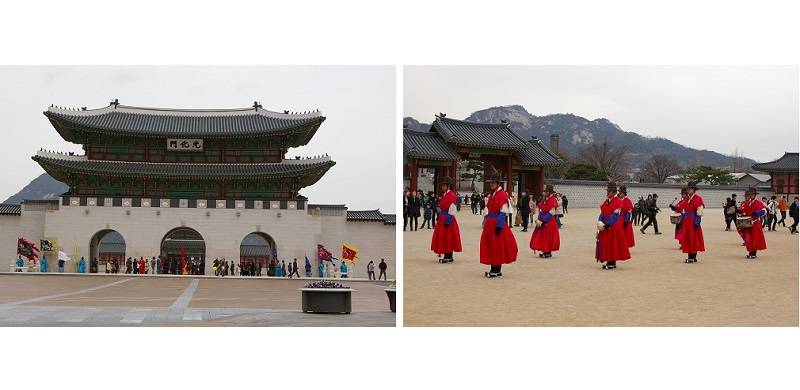
Ever since we saw the Eight Immortals opera in Beijing, we had been planning to visit South Korea.
Late one March we arrived in Seoul. A blast of cold air greeted us as we emerged from the airport. Winter was still very much there in the Korean peninsula. We had come to see the imperial palaces, check out the local markets and visit the Demilitarized Zone (DMZ).
Our hotel was centrally located and several palaces were located within walking distance. The largest, Gyeongbokgung, was built by the Joseon dynasty in 1395. We went there the very next day. The folk-art museum in the palace was very nice. It had a pavilion which featured a total life cycle display (birth to death in various stages).
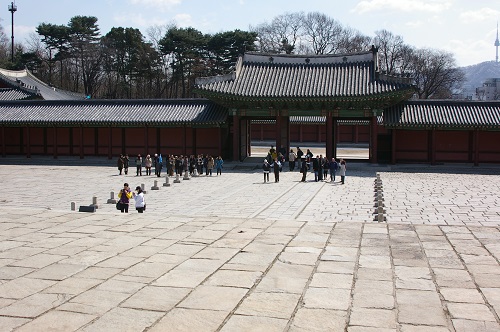 Located nearby was the Deoksugung palace. The changing of the royal guards’ ceremony was very colorful and accompanied with the beating of a large drum. Of course, the guards were totally non-communicative, but we were allowed to take pictures with them (unlike our experience in the Forbidden City in Beijing).
Located nearby was the Deoksugung palace. The changing of the royal guards’ ceremony was very colorful and accompanied with the beating of a large drum. Of course, the guards were totally non-communicative, but we were allowed to take pictures with them (unlike our experience in the Forbidden City in Beijing).
Another day we toured the city. Its architecture was very eclectic, as if Seoul was trying to discover its identity. A lot of the high-rise buildings had a generic colorless personality. We learned later they were built soon after the Korean War. They resembled the Stalinist structures we had seen in Beijing.
We also took time to check out the Lotte department store, a high rise with escalators. It was jammed packed with shoppers despite having prices that were three times of what we had seen in San Francisco. At some point, sheer claustrophobia drove me out of the store. As I turned back for a final look, I saw shoppers streaming out of the three stairs at the end, like water spilling off a dam. It sure was popular.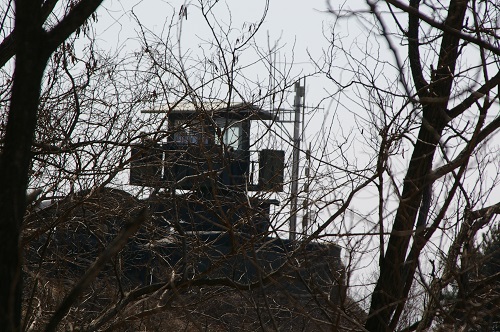
At the other end were the traditional markets. Just about everything could be purchased there, in an open-air, festive atmosphere.
Another day we went to check out the views from the North Seoul tower. They were stunning. Later, we took a ride in the fabled cable car. It was the steepest that I had encountered. It convinced me that vertigo cannot be conquered by simply wishing it away, unlike what I heard on the Dr. Oz show. Later, we discovered that the best views of the Seoul skyline were to be found by cruising the Han River.
Seoul’s downtown area could have been anywhere. We saw people walking around with cell phones, talking away with their friends far and near. One walker was also using a second cell phone to text. The last time I saw this “both hands on phones” phenomenon was in Manhattan. There was an abundance of restaurants. You could find just about anything you wanted in many of the fine eateries but food was not cheap.
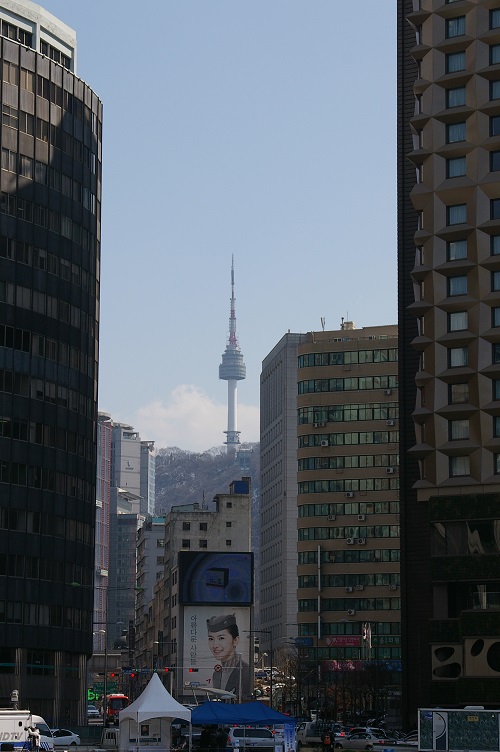 Our buffet at the Westin Chosun was truly international and sumptuous to a fault. We would linger there for more than an hour everyday. The Chinese section had a mural of Chairman Mao and the Tiananmen Square behind it. The Japanese section had a mural of Mt. Fuji. We ate Chinese food, Japanese food and Korean food.
Our buffet at the Westin Chosun was truly international and sumptuous to a fault. We would linger there for more than an hour everyday. The Chinese section had a mural of Chairman Mao and the Tiananmen Square behind it. The Japanese section had a mural of Mt. Fuji. We ate Chinese food, Japanese food and Korean food.
But one evening we succumbed to the California Pizza Kitchen that was just across the street. And for our last meal (a lunch), we wandered into a Middle Eastern place called Saffron. It was beautifully decorated but just about every item on the menu could have come from an Indian restaurant. The Indian person at the entrance had aroused my reflexes as to whether it was Middle Eastern or India. Despite the confusion of identity, the food was great.
We encountered language problems everywhere we went. But we saw the iPhone being used to effortlessly translate phrases by cab drivers and their dispatchers - and ultimately started doing the same ourselves.
One late afternoon, as the weather was getting cold, we were drawn to a street vendor who was exuding warmth by frying meat and selling it on skewers. As I got closer to the wok, wondering what was being fried, all I saw was a coiled hose pipe. So, I took an even closer look. My goodness! It was a snake that had been skinned. It had the saddest looking expression in its eyes. People all around us were snacking on snake kabob, an unusual delicacy! The sight caused us to skip dinner that evening. Our appetite had vanished.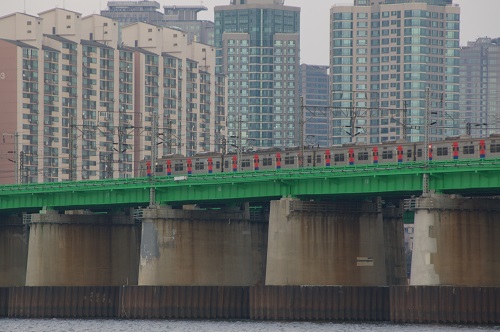
Our tour of the Demilitarized Zone (DMZ) was very educational and rewarding. One good thing about going on a tour is that you get a nice overview of the place that you are about to visit from an English-speaking guide. Also, you can relax and not worry about getting lost in a foreign country whose language you don’t understand. The downside is that the tour will make mandatory stops at stores that sell the local fare. In Seoul, we found that was ginseng and amethyst.
Once we arrived at the DMZ, we were overcome with emotion, knowing we were standing on soil that had once been the venue of a major war and which was wedged between two countries that are still, technically, in a state of war.
I was somewhat disappointed that there were no weapons on display. No artillery batteries or machine guns were on display, not even soldiers with automatic rifles. Perhaps they were all there, just visible to the naked eye. Or maybe that was just part of the requirements of being a DMZ.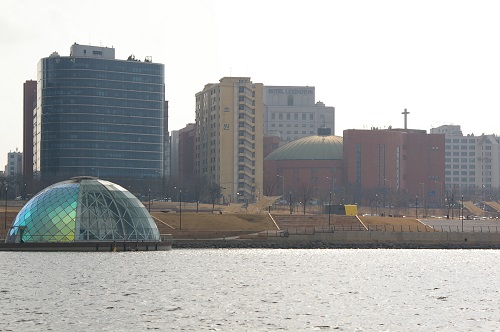
We were allowed to go down a thousand feet at a steep angle to enter a tunnel that the soldiers from the North had dug in to invade the South. This was discovered by accident in 1974 and the north initially claimed that it was an old coal mine shaft. The tunnel was big enough, we were told, to let in an entire infantry division in just an hour.
The five days we spent in Korea were among the most pleasant we have spent in Asia. They were culturally and historically enriching in more ways than one. But in our five days, we probably saw only 5 percent of the greater Seoul area. There is so much more waiting to be seen on a future journey.
Late one March we arrived in Seoul. A blast of cold air greeted us as we emerged from the airport. Winter was still very much there in the Korean peninsula. We had come to see the imperial palaces, check out the local markets and visit the Demilitarized Zone (DMZ).
Our hotel was centrally located and several palaces were located within walking distance. The largest, Gyeongbokgung, was built by the Joseon dynasty in 1395. We went there the very next day. The folk-art museum in the palace was very nice. It had a pavilion which featured a total life cycle display (birth to death in various stages).
 Located nearby was the Deoksugung palace. The changing of the royal guards’ ceremony was very colorful and accompanied with the beating of a large drum. Of course, the guards were totally non-communicative, but we were allowed to take pictures with them (unlike our experience in the Forbidden City in Beijing).
Located nearby was the Deoksugung palace. The changing of the royal guards’ ceremony was very colorful and accompanied with the beating of a large drum. Of course, the guards were totally non-communicative, but we were allowed to take pictures with them (unlike our experience in the Forbidden City in Beijing).Another day we toured the city. Its architecture was very eclectic, as if Seoul was trying to discover its identity. A lot of the high-rise buildings had a generic colorless personality. We learned later they were built soon after the Korean War. They resembled the Stalinist structures we had seen in Beijing.
We also took time to check out the Lotte department store, a high rise with escalators. It was jammed packed with shoppers despite having prices that were three times of what we had seen in San Francisco. At some point, sheer claustrophobia drove me out of the store. As I turned back for a final look, I saw shoppers streaming out of the three stairs at the end, like water spilling off a dam. It sure was popular.

At the other end were the traditional markets. Just about everything could be purchased there, in an open-air, festive atmosphere.
Another day we went to check out the views from the North Seoul tower. They were stunning. Later, we took a ride in the fabled cable car. It was the steepest that I had encountered. It convinced me that vertigo cannot be conquered by simply wishing it away, unlike what I heard on the Dr. Oz show. Later, we discovered that the best views of the Seoul skyline were to be found by cruising the Han River.
Seoul’s downtown area could have been anywhere. We saw people walking around with cell phones, talking away with their friends far and near. One walker was also using a second cell phone to text. The last time I saw this “both hands on phones” phenomenon was in Manhattan. There was an abundance of restaurants. You could find just about anything you wanted in many of the fine eateries but food was not cheap.
 Our buffet at the Westin Chosun was truly international and sumptuous to a fault. We would linger there for more than an hour everyday. The Chinese section had a mural of Chairman Mao and the Tiananmen Square behind it. The Japanese section had a mural of Mt. Fuji. We ate Chinese food, Japanese food and Korean food.
Our buffet at the Westin Chosun was truly international and sumptuous to a fault. We would linger there for more than an hour everyday. The Chinese section had a mural of Chairman Mao and the Tiananmen Square behind it. The Japanese section had a mural of Mt. Fuji. We ate Chinese food, Japanese food and Korean food.But one evening we succumbed to the California Pizza Kitchen that was just across the street. And for our last meal (a lunch), we wandered into a Middle Eastern place called Saffron. It was beautifully decorated but just about every item on the menu could have come from an Indian restaurant. The Indian person at the entrance had aroused my reflexes as to whether it was Middle Eastern or India. Despite the confusion of identity, the food was great.
We encountered language problems everywhere we went. But we saw the iPhone being used to effortlessly translate phrases by cab drivers and their dispatchers - and ultimately started doing the same ourselves.
One late afternoon, as the weather was getting cold, we were drawn to a street vendor who was exuding warmth by frying meat and selling it on skewers. As I got closer to the wok, wondering what was being fried, all I saw was a coiled hose pipe. So, I took an even closer look. My goodness! It was a snake that had been skinned. It had the saddest looking expression in its eyes. People all around us were snacking on snake kabob, an unusual delicacy! The sight caused us to skip dinner that evening. Our appetite had vanished.

Our tour of the Demilitarized Zone (DMZ) was very educational and rewarding. One good thing about going on a tour is that you get a nice overview of the place that you are about to visit from an English-speaking guide. Also, you can relax and not worry about getting lost in a foreign country whose language you don’t understand. The downside is that the tour will make mandatory stops at stores that sell the local fare. In Seoul, we found that was ginseng and amethyst.
Once we arrived at the DMZ, we were overcome with emotion, knowing we were standing on soil that had once been the venue of a major war and which was wedged between two countries that are still, technically, in a state of war.
I was somewhat disappointed that there were no weapons on display. No artillery batteries or machine guns were on display, not even soldiers with automatic rifles. Perhaps they were all there, just visible to the naked eye. Or maybe that was just part of the requirements of being a DMZ.

We were allowed to go down a thousand feet at a steep angle to enter a tunnel that the soldiers from the North had dug in to invade the South. This was discovered by accident in 1974 and the north initially claimed that it was an old coal mine shaft. The tunnel was big enough, we were told, to let in an entire infantry division in just an hour.
The five days we spent in Korea were among the most pleasant we have spent in Asia. They were culturally and historically enriching in more ways than one. But in our five days, we probably saw only 5 percent of the greater Seoul area. There is so much more waiting to be seen on a future journey.

